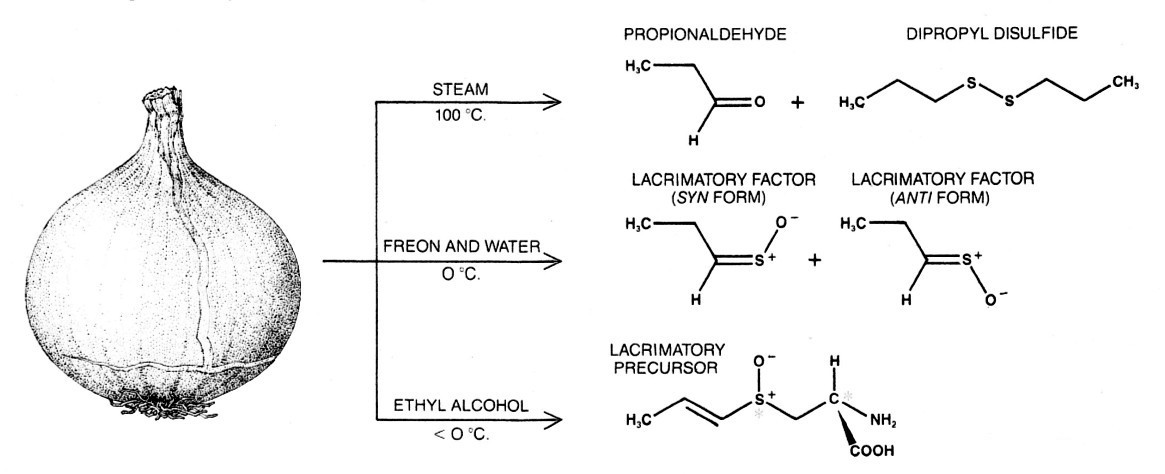Dies ist eine alte Version des Dokuments!
Allium cepa L. - Liliaceae - (common) onion, Zwiebel, Küchenzwiebel
Biennial herb, up to 120cm tall, native probably to West Asia, only known in cultivation (nearly everywhere); various in habit, large in bloom; leaves hollow, tubular, radical and basal, swollen; stem swollen below middle; flowers white, many, in large umbel subtended by 2 or 3 reflexed bracts; bulbs often large.
„The onion of commerce, Allium cepa is widely cultivated as a biennial in North America, Europe, and Asia. It is unknown in the wild and is probably derived from A. oschanini of central Asia. The cultivated form is often polyploid (2n = 16, 32, 54) and possibly of hybrid origin. It exists in numerous cultivars, a few of which form large bulbils in the umbel.“
http://www.efloras.org/florataxon.aspx?flora_id=1&taxon_id=200027457
Allium cepa L. var.aggregatum G. Don = Allium cepa var.ascalonicum = Allium ascalonicum auct.: shallot, Schalotte (plant with aggregate cluster of several bulbs)
Allium cepa L. var.cepa = (bulb) onion, Spanish onion, spring onion, Küchenzwiebel, Frühlingszwiebel (plant with single bulb)
„In Allium cepa (cv. Creamgold), A. cepa (cv. Bunching Onion), A. porrum (leek) and A. sativum (garlic), fructans were the only nonstructural carbohydrates detected apart from glucose, fructose and sucrose. No starch or members of the raffinose series of oligosaccharides were detected. Both cultivars of A. cepa, and A. porrum had fructan polymers of the same length. “
[Differences in fructan content and synthesis in some Allium species., Darbyshire, B., Henry, R.J., New Phytologist, Vol.87(2), 1981, 249-256]
„Sulfur compounds extracted from onions also depend on the conditions of the extraction. Steam distillation yields propionaldehyde and dipropyt disulfide. The solvent Freon (mixed with water at zero degrees Celsius) yields the lacrimatory lactor: the substance that makes people cry when slicing an onion. The factor has two forms, designated syn and anti, the syn form predominates. Pure ethyl alcohol at a subzero temperature yields the lacrimatory precursor. It is a structural isomer of alliin; that is, the two differ only in structure. In onions an enzyme converts the lacrimatory precursor into the lacrimatory factor.“
 [The chemistry of garlic and onions., Block, E., Scientific American, Vol.252(3), 1985, 114]
[The chemistry of garlic and onions., Block, E., Scientific American, Vol.252(3), 1985, 114]
„Various Allium hybrids, obtained by the crossbreeding of Allium cepa (onion) as the mother plant and six taxonomically distant wild species obtained by embryo rescue, were investigated with special respect to their individual profiles of cysteine sulfoxides as well as enzymically and nonenzymically formed aroma substances. Alliinase (EC 4.4.1.4) catalyzes the conversion of odorless (+)-S-alk(en)yl-l-cysteine sulfoxides into volatile thiosulfinates. These thiosulfinates were converted to a variety of sulfides by steam distillation… Cysteine sulfoxides as well as alliinase activity were found in all investigated samples at different levels, but (+)-S-methyl-l-cysteine sulfoxide (methiin) was the most abundant sulfoxide present. (+)-S-(trans-1-Propenyl)-l-cysteine sulfoxide (isoalliin) is typical for onion and was found in all investigated hybrids. The pattern of the other cysteine sulfoxides depended strongly on the parent plants used…
Isoalliin is typical of onion (A. cepa) and is the main cysteine sulfoxide of this species. Remarkable relative amounts were also found in the wild species A.altyncolicum (74%), A.chevsuricum (49%), and A.senescens (43%). These three wild species are related to A. cepa and belong also to the same subgenus Rhizirideum. Isoalliin was previously described for wild species belonging to this subgenus…
In comparison to the usually performed aroma isolation techniques such as steam distillation, a surprisingly high reproducibility, sensitivity, and selectivity of all relevant S-containing aroma compounds were achieved by solvent extraction or simultaneous distillation/extraction (SDE).“ Dominant compound was dipropyl disulfide (46.3%), followed by (E)-1-propenyl propyl disulfide (7.7%), methyl propyl disulfide (1.2%), di-2-propenyl sulfide (0.9%), and 2-propenyl propyl disulfide (0.5%).
[Characterization of some Allium hybrids by aroma precursors, aroma profiles, and alliinase activity., Keusgen, M., Schulz, H., Glodek, J., Krest, I., Krüger, H., Herchert, N., Keller, J., Journal of agricultural and food chemistry, Vol.50(10), 2002, 2884-2890]

Sibthrop, J., Smith, J.E., Flora Graeca (drawings), vol.4, t.26 (1823)
http://plantgenera.org/species.php?id_species=39588
